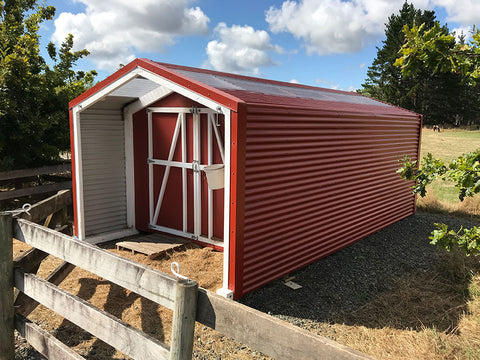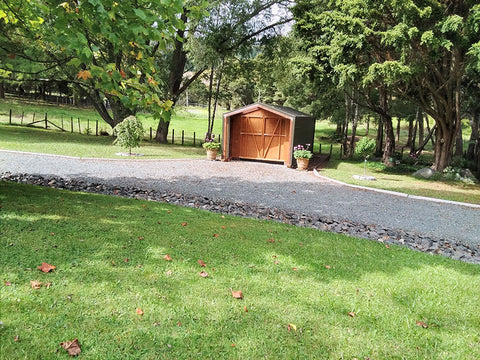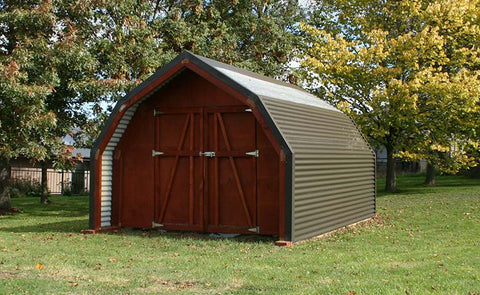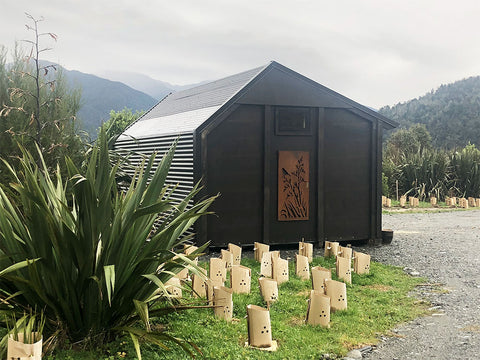A good lick of paint is all you need to transform your garden shed from a tired looking outhouse to an attractive garden feature.
If you’re painting your garden shed make sure to get online and gather inspiration. Before you decide on a colour scheme, collect swatches and check that they compliment other colours in your garden. When you’re ready to paint, consider any prep work and purchase enough paint to complete your project.
A well maintained garden will look great and encourage you to spend more time in it. Not only that, it can add value to your property and your shed is a focal point of your overall aesthetic. Whether you’re greenfingered or not

Can you paint a garden shed?
Maybe your shed is a little worn out, maybe you want to make it a focal point of the garden or maybe you’re just tired of the colour. Whatever your reasoning for transforming your shed, enjoy the process and get inspired:
Gather inspiration
Online is a great place to find inspiration. At the touch of a button you can search for literally thousands of ideas to transform your shed. Try social media platforms such as Pinterest. The algorithm works in such a way that once you like or save one design, it’ll take note of your taste and show you other variations. Meaning you can head down a rabbit hole of inspiration.
Decide on a colour scheme
Maybe you have a colour scheme in mind already or maybe you’re struggling to decide. You can always head to the local hardware store and pick up swatches or test pots. Put them up against your shed, compare them to any other colours you may have around your garden, even the outside of your house to make sure they’ll compliment each other.
Get painting
Once you’ve collected all your inspiration and decided on a colour scheme, make sure you purchase enough paint for the job. You will also need to consider any prep work you may need to do before you start painting. Below, we’ve answered all of the most common questions you may have for painting your garden shed to help you along the way.

What is the best colour for a shed?
The best colour(s) for a shed will depend on what the intended purpose is. Will this shed house garden tools, mowers, bags of fertiliser and potting soil, and maybe even that lawn tractor? Or perhaps, a workshop, craft space, she-shed, man cave, or a private office or studio is what you’ve been planning.
Do you want to match your house colours, leave your shed more natural or rustic. or make a bold statement? The best colour will depend on your taste. The important part is that paint, stain and other outside treatments such as clear wood preservative will make your shed last longer. Next to using top quality materials like Outset Buildings and appropriate ventilation, painting your shed will make your investment last much longer. And after all, it’s paint or stain and can be changed.

How can I change the colour of my garden shed?
If you’ve decided whether you want your shed to look more natural, to match your house colours (mini-me) or contrast with them, maybe you just want it to stand out or you’re painting it for the first time. If you want to keep a more rustic looking structure where the natural beauty of the wood grain stands out, then a clear or tinted translucent finish is what you're looking for. Opaque stains are more like paint, in that most will block the wood grain pattern.
If your shed is already stained or painted, do you want to stay with the same colours or change them? With transparent stains or clear wood preservatives, staying with the same colour or going to a darker stain are your best options. The same is true for opaque stains, you’ll have to stick with the colour or go darker. However, when you use exterior house paint, you can let your imagination run free and pick a colour scheme you like or want to try. It's not a permanent choice with paint - if the colours don’t suit you anymore, the cost of changing them is a couple gallons of paint and some time.
If you cover a darker colour or a stain with a lighter colour, you’ll need to pre-treat the stain or darker colour with a base coat in white or off-white, both to cover the darker colour and/or prepare the surface for a different type of paint (especially if painting over stains and other preservatives). Read directions and follow them carefully.
Should I paint my shed the same colour as my fence?
If you’re going for a uniform look you might want to paint it the same colour as your fence. That depends on whether your scheme is to blend the shed in with the fence. If you like the colour of your fence already, and especially if you have some of that paint leftover, then it may be a good idea to blend it all in together. Remember, if you decide to change the colour, it’s only stain or paint and some additional time.
What should I paint my shed with?
If you want your shed to last, paint, stain or preserve it with the best material you can afford, Although quality paints, stains and preservatives will tend to be more expensive, last longer and require fewer repaintings over the life of the shed. The cheaper products will work, but will need to be re-applied more often - and let’s face it, who wants to paint their shed every year or two?
How often should you paint your shed?
Depending on the quality of the stain, paint or wood preservative, you may need to repaint the exterior of your shed every 5-10 years to make it last.

Is black a good colour for a shed?
You can paint your shed any colour you want! If black paint fits in with the rest of your scheme, that colour is fine. But remember in the warmer summer months, black will absorb the sun’s heat and the inside of your shed could be sweltering. If you’re shed is made from plastic or certain types of wood you’ll want to avoid painting it black, the heat can damage the material. But if a sauna/hot house is what you’re going for - black paint is the way to go, especially in the cooler months.
If you’re adamant about painting your garden shed black the good news is there are safe products you can use. We recommend using Resene CoolColour. Their range of dark paints include sophisticated pigment technology that reflect the sun’s energy instead of absorbing it. Protecting your shed for many years to come.
Remember, with more paint and time, you can always change the colour if black is no longer working for you.
How do you paint a wooden garden shed?
Painting a shed is the same as painting any other structure. You can use brushes, rollers or sprayers, or a combination of all of them to apply the paint/stain/preservative. Start at the top and work your way down. If you’re changing colours, especially if you’re going lighter, or painting over a stain, you may need a base or prep coat first. Always use the best quality paint/stain/preservative you can afford.
Can I paint over a stained wood shed?
You can paint over a translucent or opaque stained shed with some surface preparation. Often, stains incorporate polyurethane coating in them to make the stain and surface last longer. However, a polyurethane or varnished surface may not allow paint of a different kind to adhere to it. Thus, it’s common to prepare the stained surface with an appropriate base coat that will allow another type of paint to adhere and prevent the stain from “bleeding” (showing) through the painted surface.
Can you paint a shed with a roller?
Applying paint can be with brushes, rollers or sprayers, or the combination. Large flat surfaces are particularly good for roller applied stains and paints. Brushes can be used for the entire painted surface, but they’re more time consuming than rollers on large flat surfaces. Spraying is a good alternative for paint/stain/preservative application, but it typically requires that certain areas be protected from spray or overspray by covering them with impermeable paper and/or painter’s tape. Spraying paint/stain/preservatives usually provides a thinner coat of the product, even when a second coat is applied. Because of that, sprayed surfaces may have to be repainted more often, closer to every 3 years, rather than every 5 years.
Do you need to treat a shed before painting?
If a shed has never been painted before, you may or may not have to pre-treat the surface before painting. Do you plan to use a clear preservative, translucent or opaque stain? If so, the surface may not require any pre-treatment, but 2, and maybe three, coats of preservative or stain may be required. If stain includes a polyurethane finish, 2 coats may be sufficient.
How do you spray a garden shed?
Spraying stain, preservative or paint, is one of the easiest and fastest methods of covering a surface. Three things to remember when spraying your shed:
- Protect surfaces that you don’t want painted with impermeable paper and painter’s tape to protect from spray/overspray;
- Certain paints may require dilution before being applied with a sprayer - make sure you use the appropriate agent to thin the paint;
- While a properly applied spray coat will tend to be more even and get into all of the nooks and crannies that brushes or rollers may miss, the coats are thinner, apply at least twice (and maybe even a third coat), and repeat every 3 years.
Spray painting is an art and requires that you practise if you haven’t used a sprayer before. The technique requires that you keep moving continuously while applying the paint to prevent too much paint from accumulating in spots and “running” (forming drips from excess paint in the area). Once those drips dry, they become a permanent feature of that painted surface.
If you have any questions about adding a garden shed to your farm or garden, feel free to contact the team at Outpost Buildings today.




